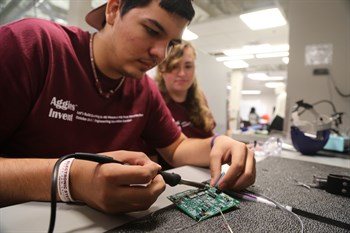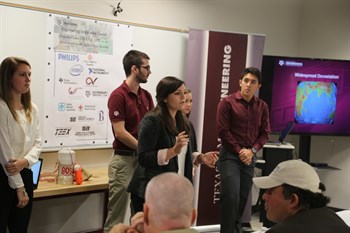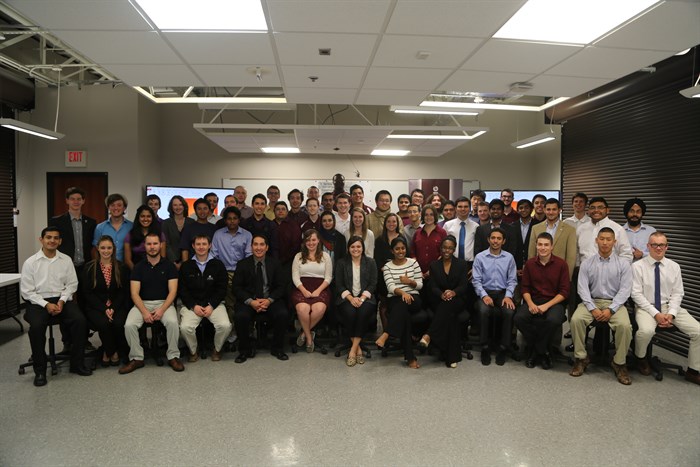Team Vapor Space won first place at the second Aggies Invent for its multi-purpose tool to be used by first responders in hazmat suits. The prototype, which included a hammer, scraper and various wrenches, earned the five-member team $750. Approximately 70 students and 18 mentors participated in the event.

Aggies Invent is a program that promotes innovation and entrepreneurial mindset among students at Texas A&M University. The concept is to gather interested students, provide them with the potential needs (medical, energy or others), allow them to self-select teams, give them access to and support from the Engineering Innovation Center (EIC), and have them create prototypes in 48 hours.
The focus for this particular Aggies Invent was on creating prototypes for first responders based on need statements supplied by the City of College Station Fire and Police Departments, Texas A&M Veterinary Emergency Team, Bryan Police Department, Sandia National Laboratories, the Mary K. O’Connor Process Safety Center, the Texas A&M Engineering Extension Service (TEEX), HazMat Response, Center for Robot Assisted Search and Rescue (CRASAR), Philips Healthcare and the American Red Cross.
“The unique thing about Aggies Invent is that students get to work on real problems, guided by mentors who are experts in the field, and build prototypes in a state of the art facility, all in 48 hours,” said Rodney Boehm, industry mentor and mediator of Aggies Invent. “This is where theory meets practice and the engineering design process gets embedded in their very core.”
 Team Vapor Space, which used a 3D printer in the EIC to create its prototype, include Dayana Hansley, biomedical engineering freshman, Gabrielle Krzysiak, mechanical engineering sophomore, Andrew Michaud, petroleum engineering freshman, Timothy Paulsen, mechanical engineering sophomore and Kiran Prasad, mechanical engineering master’s student formed the team.
Team Vapor Space, which used a 3D printer in the EIC to create its prototype, include Dayana Hansley, biomedical engineering freshman, Gabrielle Krzysiak, mechanical engineering sophomore, Andrew Michaud, petroleum engineering freshman, Timothy Paulsen, mechanical engineering sophomore and Kiran Prasad, mechanical engineering master’s student formed the team.
Second place went to team Raising the Bar, which developed a wearable device for search and rescue dogs and crews that monitors radiation, temperature and gas levels in the air. This modular system allowed rescuers to change out sensors depending on the hazard present and wirelessly transmit the measurements and location back to a central receiver for monitoring.
Raising the Bar received $500 for its effort. The members of team Raising the Bar included Kaitlin Frierson, electrical engineering freshman, Jesse Johns, nuclear engineering Ph.D. student, Dakotah Karrer, electronic systems engineering technology junior, Vince Rodriguez, electronic engineering technology junior and Elikem Wood, biomedical engineering masters student.
The Aggies Invent Rescue Squad (AIRS) received $250 as the third-place prize for its prototype of a GPS location module that could be dropped into disaster areas and be used by survivors to notify search and rescue teams of their location. Tadeo Huerta, mechanical engineering senior, Melinda McClure, chemistry engineering senior, Melissa McNeill, computer science and engineering senior, Sierra Silla, industrial distribution freshman, Wesley Vance, computer science senior and Scott Weaver, computer science and engineering junior composed the AIRS team.
The first, second and third place teams received an offer to work with Startup Aggieland in the spring to further develop their prototypes.
The judges were so impressed by all the teams’ hard work that they awarded the rest of the nine teams fourth place and a $100 prize.

The weekend-long event started at TEEX’s Disaster City on Friday afternoon. Disaster City is a mock community featuring full-scale, collapsible structures designed to simulate various levels of disaster and wreckage, which can be customized for the specific training needs of any first responders. This location was a perfect setting since the purpose of this Aggies Invent was to use an engineering design process to build prototypes in 48 hours to solve typical problems that first responders encounter.
At Disaster City, students participated in a speed-dating activity that allowed them to get familiar with the need statements, sponsors and mentors. After, the students selected their own teams based on the information they received. The sponsors submitted 27 need statements and 11 were chosen. Students formed interdisciplinary teams of four to six people ranging from freshmen to Ph.D. candidates
Students spent the rest of the weekend at the EIC working to create a working prototype to solve the need they had selected. The EIC is a 20,000 square-foot rapid prototyping facility consisting of a fabrication center, which includes 3D printers, a laser cutter and other production technologies. Some of the sponsors provided the teams with special supplies that they might need to create their prototype.
On Sunday afternoon, all teams presented their prototypes to a panel of judges. The judges were Dr. Jon Mogford, vice chancellor of research, Dr. Dale Cope, TEES director of industry assistance, Dr. Richard Lester, executive director for the Center of New Ventures and Entrepreneurship, Dr. Dilma Da Silva, department head of computer science and engineering and Mr. Jose Quintana, president of AdventGX Corporation .
Aggies Invent benefits participants by allowing them to take what they learn in class and apply it to real world problems.
